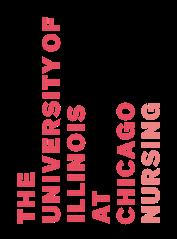

Nurses Run for Office
ANA-Illinois knows that the perspective of a nurse is extremely valuable, especially during health care debates. As direct caregivers, nurses spend more time with patients than healthcare providers in most other disciplines. If we don’t stand up for the issues that are important to us, those with competing interests in healthcare may be the only ones whose voices are heard. Many recognize that nurses are both educationally and intellectually prepared for public office, and that nurses have little if any self-serving agenda in health care reform debates. Nurses bring a legitimate altruistic interest in patient and community health.
In the last several months, ANA-Illinois has had conversations with two nurses from Illinois who have found themselves either being appointed to serve in the Illinois General Assembly or having announce their bid for a Congressional seat. We are pleased to provide you with information about both individuals.
NATALIE PHELPS FINNIE
Natalie Phelps Finnie became the first woman to represent Illinois’ 118th district Wednesday, when Democrats appointed her to replace her cousin, Brandon Phelps, who resigned from office last week. She is also the first advanced practice registered nurse to serve in the General Assembly.
She says she will make the opioid crisis and bringing jobs back to Southern Illinois, her priorities at the Illinois capitol.
A news release sent by the 118th District office in September about the appointment notes that the Elizabethtown Democrat is a nurse, wife and mother of three. She has spent much of her nursing career as an advanced practice registered nurse at Gallatin Wellness Center, which is a school-based clinic.

Phelps Finnie says she makes tough choices every day, and will bring that same attitude to the General Assembly.
“I’m a Christian, I’m a mother, I’m a wife, I’m a nurse practitioner. I think that says a lot,” she said.
Phelps Finnie stressed her health care experience, saying:
“In my clinic, I’ve seen the challenges we face firsthand. The opioid drug crisis is taking a toll on entire families and communities. When businesses ship our jobs overseas to pad their profits, families struggle to build a middle-class life and young people are often unable to receive basic medical care. Every day I see the faces of the precious children who walk into my clinic, and as state representative I will continue my fight to give them access to the kind of future that every child deserves.”
Phelps Finnie is will be facing an election in 2018, as an association, we are urging nurses in her district to volunteer on her campaign and to organize around making sure Phelps Finnie is elected in November 2018.
LAUREN UNDERWOOD
Lauren Underwood is a nurse from Naperville who is stepping forward to run for Congress to represent the Illinois 14 district.
Lauren Underwood has hands-on experience in America’s healthcare industry. Lauren was appointed by President Obama to serve as a Senior Advisor at the U.S. Department of Health and Human Services (HHS). During her time in the administration, Lauren helped communities across the country prevent, prepare for, and respond to disasters, bioterror threats and public health emergencies. As a career public servant at HHS, Lauren helped implement the Affordable Care Act — broadening access for those on Medicare, improving healthcare quality and reforming private insurance.
Thank you to our Sponsor & Exhibitors
ANA-Illinois successfully launched its new format for the annual meeting on November 4, 2017 in Bloomington/Normal at the Marriott. ANA-Illinois members and other nurses from across the state came together to hear about public policy and professional issues important to nurses.
Arthur L. Publishing Agency, Inc - SPONSOR
Illinois Nurses Foundation
Aurora University
Dr. Seun Ross, DNP, MSN, CRNP-F, NP-C, NEA-BC, the Director of Nursing Practice & Work Environment, at the American Nurses Association addressed the group on the topic of staffing. Dr Ross discussed how study after study has demonstrated the relationship between nurse staffing levels and patient outcomes. She reviewed the work that ANA has done to promote health care quality through safe, ethical work environments for nurses. One point discussed was how to reframe the question regarding staffing. When we use data to prove that optimal staffing leads to better patient outcomes such as reduced hospital acquired conditions, lower readmission rates, shorter lengths of stay and decreased mortality rates, we are reframing the whole conversation about staffing.
Feel Good, Inc.
Illinois Association Of School Nurses
Illinois Public Health Association
Indiana Weslyan University
McKendree University Memorial Health System
The next policy issue addressed by the attendees was the issue of pain management and the current opioid crisis in Illinois. Shirley Hilzinger, FNP shared with the audience strategies to deal with pain, alternative therapies, and the need for clear communication when opioids are needed. Next the attendees were presented with The Choosing Wisely© program by Lisa Hernandez DNP, RN, CENP. Choosing Wisely aims to promote conversations between clinicians and patients by helping patients choose care that is: (a) Supported by evidence, (b) Not duplicative of other tests or procedures already received, (c)Free from harm, and (d) Truly necessary. Hernandez shared with the group nursing’s responsibility in evidence-based care.
Olivet Nazarene University
University of St. Francis
Western Governors University Nurses PAC
The next topic discussed was focused on how the risk of medical errors could be reduced by improved communication during patient handoff. Melissa Hagle MSN, APN, ACNP-BC, CCRN described the benefits of integrating handoff into the electronic medical record. Hagle shared lessons learned as her hospital developed a tool to improve handoff among providers in an intensive care unit.
The last session of the day focused on the healthy nurse, healthy nation domain of quality of life. Julia Sarazine DNP, APN, FNP-BC lead the discussion on the topic of Mindfulness – Preventing Burnout and Developing Resilience.
The launch of the new format was a great success. Nurses stated they enjoyed the opportunity to come together to discuss topics of relevance, network, share and spend time with the exhibitors. We look forward to repeating the event next year on November 3rd in Lisle at the Lisle Hilton. We hope to see you there.

Nurses Run for Office continued on page 2
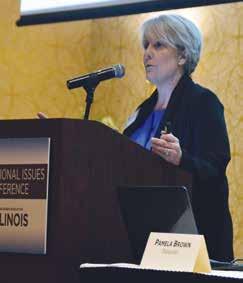
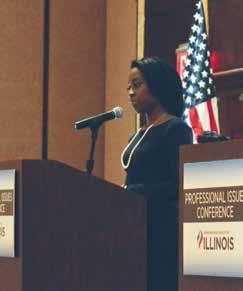
MESSAGE FROM THE INF PRE S I DENT
The Third Age Perspectives
Maria Connolly
Dear Illinois Nurse Colleagues,
I am Maria Connolly, a member of the Illinois Nurses’ Foundation Board of Directors and a lifetime member of the American Nurses’ Association -Illinois. As a registered nurse for over fifty years, I fit into a category of life entitled the Third Age. What is Third Age? The Third Age begins around 50 years of age until around 75 years of age. According to a study by Dr. William Sadler, we will live an average of thirty years longer than past generations. Third Age begins as professional advancement becomes less important and we become more fulfilled. Along with this sense of fulfillment, wisdom and self-awareness brings comfort with ourselves and others. Usually by this age, we are freed from the responsibility of raising our own families and our professional nursing career has stabilized. Sadler says we can create our Third Age so it really becomes a case of the best is yet to be!
How we chose to spend these thirty extra years is worth some time and reflection. One thing I know for certain, every registered nurse has expertise and knowledge that doesn’t evaporate with age. Rather the gift of nursing knowledge and expertise can be shared directly or indirectly among our less experienced nursing colleagues. For example, one of my nursing friends, is willing to work one day a week in an outpatient
Nurses Run for Office continued from page 1
She is committed to fighting for families and believes that strong jobs, smart investments, and access to affordable health care will put our region back on track.
Lauren will bring her firsthand knowledge to Washington and work to propose measures that will preserve and expand access to healthcare for Illinois families. Lauren currently works with a Medicaid plan in Chicago. Every day, Lauren works with clinical staff to ensure the plan provides high-quality, cost-efficient care. Lauren is also a teacher, preparing future nurse practitioners through Georgetown University’s online master’s program.
Lauren is a graduate of the University of Michigan and Johns Hopkins University.
“I’m running for Congress because I believe this moment in history requires courageous people to stand up and fight to restore our voice in Washington.”






orthopedics clinic. She has worked in the system for 35 years is able to step right in and help and mentor new nurses. Another nurse friend, a former pediatric nurse manager, rocks babies in the nursery, and the staff nurses enjoy her expert physical assessment abilities and gentle instructions.
As for me, I find my volunteer work on the INF Board one way to influence and shape nursing in Illinois. Our INF philanthropic activities provide nurses the scholarship resources for furthering their education, assisting in their research endeavors, and informing the public about health issues and nursing. I am inviting you to contact me or any of the INF Board members and share your gift of nursing knowledge and expertise with our ANA-Illinois’s Illinois Nurses’ Foundation. Most of the work with INF is done via phone conferencing and Webinars, so if you are traveling the world or getting a health-related tune up or new parts (knees, hips, shoulder, pacemakers, etc.), we’d still like to have you share your expertise! We host many enjoyable events such as the upcoming INF Holiday Gala Fundraiser on December 9th, 2017 from 6pm-9:30pm at the Hilton, Lisle. Come out and partly with us!
So, what are you going to do with your extra thirty years?
Bower, F. & Sadler, W. (2009). Why Retire? Career Strategies for Third Age Nurses. Indianapolis: STTI.
The Nursing Voice
INF Board of Directors
Officers
Maureen Shekleton, PhD, RN, DPNAP, FAAN President
Alma Labunski, PhD, MS, RN Vice President
Cathy Neuman, MSN, RN, CNAA Secretary/Treasurer
Directors
Cheryl Anema, PhD, RN
Maria Connolly, PhD, CNE, ANEF, FCCM
Karen Egenes, EdD, MSN, MA, RN
Jacqueline Garcia, MSN, APN, NP-BC
Guadalupe Hernandez, MSN, APN, FNP-BC
Brandon Hauer, BSN, RN
Linda Olson, PhD, RN, NEA-BC
Bonnie Salvetti, BSN, RN
Kathryn Serbin, MS, DNP, RN

2015-2017 ANA-Illinois Board of Directors
Officers
Dan Fraczkowski, MSN, RN President
Ann O’Sullivan, MSN, RN, CNE, NE-BC, ANEF Vice President
Pam Brown, PhD, RN, ANEF Treasurer
Kathryn Serbin, MS, DNP, RN Secretary
Directors
Karen Egenes, EdD, MSN, MA, RN
Colleen Morley, MSN, RN, CMCN, CM
Bonnie Salvetti, BSN, RN
Crystal Vasquez, DNP, MS, MBA, RN, NEA-BC
Kathryn Weigel, MS, RN, GCNS
Editor Emeritus
If you are a nurse in the 14th District, please reach out to help on Lauren’s campaign.
We ask that all nurses regardless of their location, consider contributing to the campaigns of these two courageous nurses. We all know that running for office takes a tremendous amount of time, energy and commitment. As nurses, we need to support our colleagues and help them as they help make sure nurses and nursing’s priorities remain at the forefront of all policy discussions.
Contributions can be made at:
LAUREN UNDERWOOD https://secure.actblue.com/ donate/teamunderwood
NATALIE PHELPS FINNIE – Friends of Natalie Phelps Finnie, RR 2 Box 127, Elizabethtown, IL 62931

Editorial Committee
Alma Labunski, PhD, MS, RN
Chief Editors
Lisa Anderson-Shaw, DrPH, MA, MSN
Karen Mayville, MSN, PhD, RN
Members
Kathy Long-Martin, BSN, MSN, RN
Linda Olson, PhD, RN, NEA-BC
Lisa Hernandez, DNP, RN, CENP
Nancy Brent, RN, MS, JD
Executive Director
Susan Y. Swart, MS, RN, CAE
ANA-Illinois/Illinois Nurses Foundation
Article Submission
• Subject to editing by the INF Executive Director & Editorial Committee
• Electronic submissions ONLY as an attachment (word document preferred)
• Email: syswart@ana-illinois.org
• Subject Line: Nursing Voice Submission: Name of the article
• Must include the name of the author and a title.
• INF reserves the right to pull or edit any article / news submission for space and availability and/or deadlines
• If requested, notification will be given to authors once the final draft of the Nursing Voice has been submitted.
• INF does not accept monetary payment for articles.
Article submissions, deadline information and all other inquiries regarding the Nursing Voice please email: syswart@ana-illinois.org
Article Submission Dates (submissions by end of the business day) January 15th, April 15th, July 15th, October 15th











• Online classes fit your schedule
• No campus presence required
• Affordable, competitive
• RN to BSN students may transfer up to 90 of the 120 required credits and take courses full or parttime at a pace comfortable for you.
Advertising: for advertising rates and information please contact Arthur L. Davis Publishing Agency, Inc., 517 Washington Street, P.O. Box 216, Cedar Falls, Iowa 50613 (800-626-4081), sales@ aldpub.com. ANA-Illinois and the Arthur L. Davis Publishing Agency, Inc. reserve the right to reject any advertisement. Responsibility for errors in advertising is limited to corrections in the next issue or refund of price of advertisement.






















• MSN program requires 34 credits that can be completed in as little as 2 years and features a Leadership Project in a health care setting. No entrance exams are required for admission.

Acceptance of advertising does not imply endorsement or approval by the ANA-Illinois and Illinois Nurses Foundation of products advertised, the advertisers, or the claims made. Rejection of an advertisement does not imply a product offered for advertising is without merit, or that the manufacturer lacks integrity, or that this association disapproves of the product or its use. ANA-Illinois and the Arthur L. Davis Publishing Agency, Inc. shall not be held liable for any consequences resulting from purchase or use of an advertiser’s product. Articles appearing in this publication express the opinions of the authors; they do not necessarily reflect views of the staff, board, or membership of ANA-Illinois or those of the national or local associations.
PRESIDENT ' S M E S S AGE
As you have likely heard, the Nurse Practice Act, previously HB 313, was signed into law, as Public Act 100-0513 by the Governor on September 20, 2017. Despite passage of the act and signing it into law, there are still administrative tasks of the Department of Professional Regulation that are necessary prior to eligible Advance Practice Registered Nurses practicing independently. Over the past two years the Illinois Coalition of Nursing Organizations (ICNO) worked together to ensure that state law allowed authority for all nurses (LPN, RN, and APRN) to practice to the fullest level of their education and expertise. Equally important, our collective expectation is for safe and quality nursing care in all settings. Recognizing that healthcare is moving to the community instead of traditional facilities, ICNO focused on addressing the changing role of the nurse as a provider of direct care services, virtual services, and that of care coordination.

Dan Fraczkowski MSN, RN
The Illinois Coalition of Nursing Organizations will be providing feedback to the Department of Professional Regulation as the rules are developed to ensure there are no unnecessary administrative barriers as the public comment period opens. We believe that through updates in the Nurse Practice Act health care access will be expanded across Illinois. To keep up to date and get involved in this advocacy work, sign up for our free Advocacy Portal at http://cqrcengage.com/ilnurses/home. This will be the primary method of communicating information about the practice act as well as the upcoming 2018 legislative session in Springfield. Further, I hope you can join us for Student Nurse Political Action Day on Tuesday, April 17th, or Nurse Lobby Day on Wednesday, April 18th in Springfield, Illinois.
I wanted to share that this year, we now have the first nurse in the Illinois State Legislature, Representative Natalie Phelps-Finnie who was recently appointed to the seat previously held by Representative Brandon Phelps in Illinois 118th district. Also, there is a Registered Nurse running for Congress in Illinois 14th district. Lauren Underwood is an ANA-Illinois member who was born and raised in the district. She is committed to fighting for families to ensure strong jobs, smart investments, and access to affordable health care. To learn more about her visit www.underwoodforcongress. com. If you do not know whether you are in the 14th district, visit our advocacy portal! It is essential that Lauren wins in the primary, where has several opponents prior to advancing to the general election. No matter where you live, elections matter, so be sure to get out and vote on Tuesday, March 20, 2018! We will be sharing information about work to elect and support both nurses in their campaigns. This is truly an exciting time for the profession!
Congratulations to the newly elected members of the Board of Directors and Nominations and Elections committee, who were installed at our Membership

Assembly that coincided with our first annual Professional Issues Conference in Bloomington, IL on November 4th, 2017. I also would like to thank all who attended our ANA-Illinois Policy Conference held in Edwardsville, IL on November 16th, 2017. The policy conference will also be offered in other locations across the state in 2018. I’d also like to congratulate the newly elected Student Nurses Association of Illinois Board of Directors, who took office at the beginning of October 2017
As you are aware, we are experiencing an increase in violence in healthcare settings, and I wanted to share an update on our collective work through a recent ICNO meeting. The coalition met to update our progress on addressing workplace violence. Recognizing that many organizations and health systems are already working to address this multifaceted issue, we felt the need for an organized, collective approach across the nursing community. ICNO strongly supports an approach that shares resources and tools, works collaboratively, and avoids duplicative endeavors. Since the problem is greater than violence against health care workers, and solutions are complex; ICNO feels progress is always more effective when we work together. Efforts to effectively address an issue as complex and challenging as violence against health care workers must represent a shared voice moving toward creating a culture of safety in all healthcare settings. A culture of safety consists of “core values and behaviors resulting from a collective and sustained commitment by organizational leadership, managers and health care workers to emphasize safety over competing goals” (ANA, 2017)
Finally, there is so much going on here across the state and I’d like to ensure that we all have access to information and revitalize our efforts for nursing organizations to participate in a shared calendar. This allows each organization to post and view upcoming events as they plan a suitable date, time and location that can be viewed by other organizations. If your nursing organization does not yet participate in the shared Google™ calendar, please contact us to participate (info@ana-illinois.org), with “ICNO Calendar” in the subject line of your message.
Thank you for all you do for your patients and the profession,
Sincerely,
Dan Fraczkowski MSN, RN President- ANA-Illinois @NurseDanF
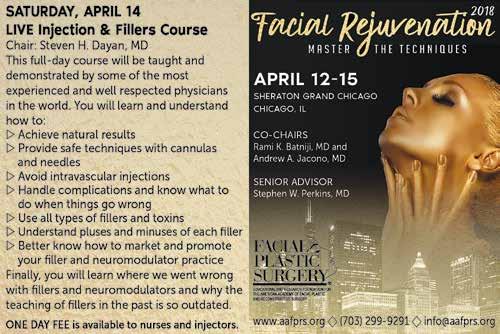
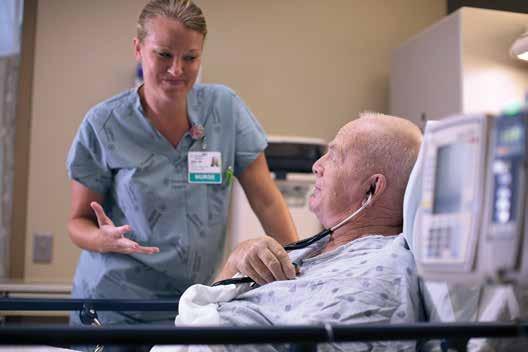
ANA-Illinois Elects President and Board Members
Members of the ANA-Illinois elect new leadership
MANTENO – Members of the ANA-Illinois voted to reelect the president for a second term and elected board of directors during the 2017 Election.
ANA-Illinois leadership includes influential nurse leaders from across the state and with a variety of backgrounds. The elected leaders’ unique experiences are sure to enhance the work of ANA-Illinois and its vision of being the recognized leader of professional nursing and nurses in Illinois.
The newly elected board members are as follows:
President: Dan Fraczkowski MSN, RN - Chicago
Secretary: Kathryn Serbin DNP, MS, BSN, CCM –Mount Prospect
Director: Colleen Morley MSN, RN, CMCN, ACMMidlothian
Director: Kathryn A. Weigel MS, RN, GCNS –Orland Park
Nominations Committee: Timbolin D Holmes MSN, APRN, CNP, ACNP-BC, ACNP-C - Bolingbrook
Nominations Committee: Benson Wright MSN, RN, CTN-B - Chicago
“The members of ANA-Illinois are advocates for both patients and fellow nurses in Illinois. Currently the future of America’s healthcare is uncertain. It is more important than ever for nurses to be involved in the decisions that impact the care of our patients and the ability of nurses to provide safe, quality care. As president of ANA-Illinois, I will continue to facilitate a collaborative approach as I lead this association and help to ensure the voice of Illinois nurses continues to be heard loud and clear in Springfield,” said Dan Fraczkowski
The new board members will join the following directors whose terms continue through October of 2018:
Vice President: Ann O’Sullivan MSN, RN, CNE, NE-BC, ANEF – Mount Sterling
Treasurer: Pam Brown PhD, RN, ANEF - Quincy
Director: Karen Egenes EdD, RN - Clarendon Hills
Director: Bonnie Salvetti BSN, RN – Marion
Director: Elaine Hardy PhD, RN – Bloomington
Nominations Committee: Lisa Hernandez DNP, RN, CENP- Mattoon
Newly Elected Board Members


Kathryn Serbin DNP, MS, BSN, CCM
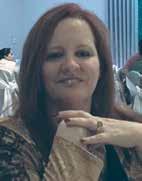
Colleen Morley MSN, RN, CMCN, ACM
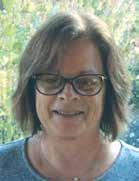
A. Weigel
GCNS
Nominations Committee: Elizabeth Davis DNP, RN –Downers Grove
Nominations Committee: Maria Connolly PhD, RN –Oak Forest
The ANA-Illinois Board of Directors are responsible for advancing the vision and mission of the association and ensuring a sustainable future for the association.
###
ANA-Illinois, a constituent member of the American Nurses Association, is a powerful network of registered nurses who are committed to advancing nursing through education, political action and workplace advocacy. ANA-Illinois is the leading voice of the approximately 187,000 professional registered nurses in Illinois.


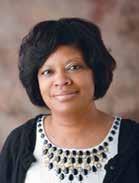
IONL Holds Annual Conference in Lisle, IL, Commemorates 40th Anniversary
On September 21 and 22, the Illinois Organization of Nurse Leaders (IONL) held its Annual Conference in Lisle, Illinois. Forward-thinking speakers explored the theme “Breaking the Status Quo: Innovations and Transformations” while commemorating the 40th anniversary of the organization.
Since its founding as the Illinois Society for Nurse Administrators in 1977, IONL has evolved to be the standard-bearer for excellence in education, mentorship and networking opportunities for all nurses in Illinois. The events at this year’s Annual Conference confirmed the organization’s crucial role in advancing nursing leadership in Illinois.
During the conference, presentations touched on a range of topics related to the latest developments in healthcare and leadership. Keynote presentations from Therese Fitzpatrick, PhD, RN, FAAN, Donna Hartley and Jan McInnis explored the ways in which nurses can use and develop their skills to advance their careers and the nursing profession as a whole.
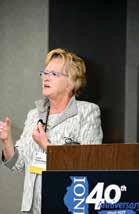
IONL Award Winner Jennifer Grenier, DNP, RN-BC presented on The Surplus Project, a program she developed at Rush University Medical Center to aid food insecure patients. At a special celebration to commemorate its 40th anniversary, IONL brought together four speakers past leadership roles within the organization to speak on the contributions that IONL has made to nursing in Illinois. Jill Mason, MS, RN, Corinne Haviley, PhD, MS, RN, Trish Anen, RN, MBA, NEA-BC, and Jane Llwellyn, PhD, RN
touched on themes of courage, compassion, creativity and collaboration in four memorable presentations. In conjunction with its anniversary celebrations, IONL launched a new awards program to highlight outstanding healthcare professionals and their contributions to nursing. We would like to specially recognize this year’s winners: Community Effort Award: Jennifer Grenier, DNP, RNBC. Awarded to an individual who demonstrated effort and service by impacting their facility, community or the nursing profession as a whole.
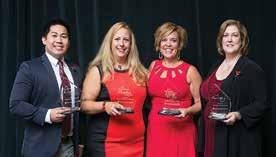
Emerging Leader Award: Raphael Parayo, BSN, RN. Awarded to an individual new to the leadership experience who has embraced their time as a new leader by seeking new opportunities and constant improvement.
Most Valuable Member: Sharon Rangel, MSN, MBA, RN. Awarded to an individual who has made a positive impact on the nursing world through their contributions to IONL.
Mentorship Award: Julie Lopez, DNP, RN, NE-BC. Awarded to an individual who champions positive culture, build trust and inspires others to always do their absolute best.
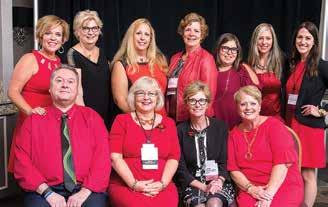
IONL is grateful for the efforts of all those involved in the planning and execution of the Annual Conference, as it was a standout success this year and a true capstone to a year of anniversary celebrations. 2018 promises to be another great year for IONL, with new benefits like free digital education for all members and more educational opportunities. Mark your calendars for the Mid-Year Conference, April 27, 2018 in Springfield, Illinois and the Annual Conference, September 20-21, 2018 in Oak Brook, Illinois.
The Illinois Organization of Nurse Leaders (IONL) is the organization of choice for nurse leaders throughout Illinois, advancing excellence in nursing leadership through educational, networking and leadership opportunities. Whether a current leader or a future one, all members of IONL are dedicated to the development, implementation and evaluation of evidence-based patient care delivery systems and healthful practice/ work environments that produce high quality, and costeffective, safe patient outcomes. For more information, visit www.ionl.org
Dan Fraczkowski MSN, RN
Timbolin D Holmes MSN, APRN, CNP, ACNP-BC, ACNP-C
Benson Wright MSN, RN, CTN-B
Kathryn
MS, RN,
Illinois Nurses Foundation Celebrates Emerging Nurse Leaders at 3rd Annual Event
The 3rd Annual 40 under 40 Emerging Nurse Leader event recognized 40 outstanding nurses in Illinois under 40 in order to celebrate and encourage exemplar dedication to the nursing profession, dedicated service within the community and the promise to grow in leadership for the advancement of nursing in Illinois.
Building on the success of previous years, the Emerging Nurse Leaders Advisory committee reconvened to review the nominations of over 100 worthy individuals for the 2017 honors. This award is designed to recognize all levels of Illinois licensed nurses, LPNs, RNs and APNs under the age of 40 years.
Nominations were received from patients, friends, family, coworkers, employers, students, etc. Award recognition recipients reflected leadership success, exemplary leadership qualities, participation in professional associations and community service.
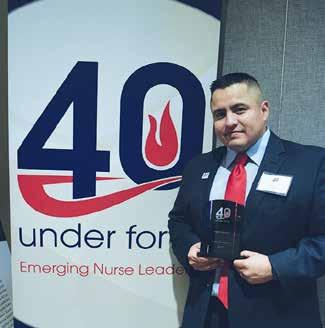
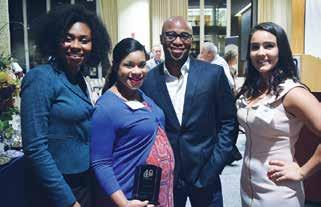
The advisory committee was led by Shannon Halloway PhD, BSN, RN, who served as emcee for the event. The remaining advisory committee team members included Dan Fraczkowski MSN, RN; Rhys Gibson BSN, RN; Stephanie Mendoza MSN, RN, Toni Scott MSN, RN, CYT; Carmen Vergara BSN, MPH, RN; and Eli Heicher MSN, RN, CENP. The committee had a difficult time as there were so many worthy candidates for this award. The committee was truly moved to have the honor of acknowledging fellow nurses who are known change agents that help shape policy statewide and beyond. Their efforts have served to expand and grow nursing practice as well as to empower our communities. Award recipients were proudly celebrated by members of their own cohort as well as Illinois nursing leaders, and of course from their family members.
Rush University Medical Center once more proved to be a perfect venue to host the event. The accomplishments of each award recognition recipient can be readily viewed at the IL Nurses Foundation website http://www.illinoisnurses.foundation/photos-fromevent_2016/.
Next year, this recognition event will take place on September 13th in Lisle at the Lisle Hilton. Please watch for further details at http://www.illinoisnurses. foundation/
Advisory Committee Consultants: Susana Gonzalez MHA, MSN, RN, CNML, Associate Dean of Academic Operations at Chamberlain College of Nursing, the Chicago Campus; Linda B. Roberts MSN, RN, Manager, Illinois Center for Nursing; Susan Y. Swart MS, RN, CAE, Executive Director, ANA-Illinois/Illinois Nurses Foundation/ Illinois Society for Advanced Practice Nursing.
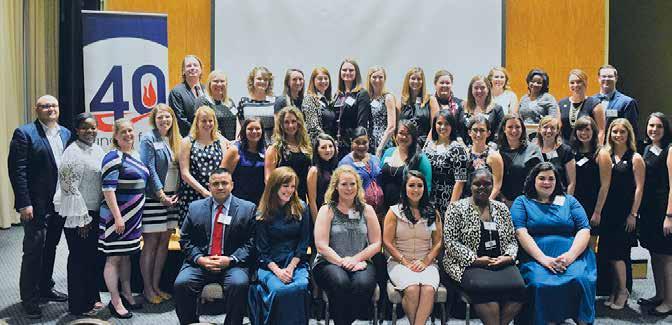
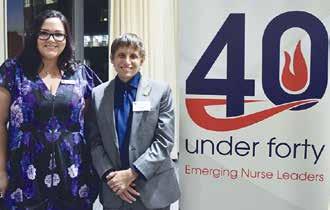
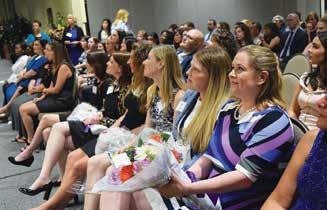

Illinois Advanced Practice Registered Nurses Elect New Board Members
MANTENO – The Illinois Society for Advanced Practice Nursing announced the election results during the association’s 2017 annual meeting at the Midwest Conference, held in Lisle, Illinois on October 7th. The new leadership includes advanced practice registered nurse leaders from across the state and from a variety of backgrounds.
The newly elected board members are as follows:
Vice President Brenda Madura MS, APRN, CNM-BC
Treasurer James Huff APRN, PMHNP-BC
Marketing Chair Betsy Gamlin MS, APRN, AGNP-BC
Program Chair Patricia Hess MSN, APRN, FNP-BC
CNM Rep Debra Lowrance DNP, APRN, CNM, WHNP, IBCLC
CNP Rep Amy Vertin APRN, NP-C
Region 3 Chair Janet Collopy APRN
Region 5 Chair Andrea Perkins APRN, FNP-BC
Region 7 Chair April Kubinski MSN, APRN, FNP-BC
The new board members will join the following directors whose terms end in October 2018:
President Ricki Loar PhD, APRN, CNP, FNP-BC, GNP-BC
Secretary Christine Foster APRN, FNP-BC
GR/PAC Chair Theresa Towle DNP, APRN, FNP-BC, CNRN
Membership Chair Dawn Kunz APRN, FNP-BC, AOCN, CHPN
CNS Rep Juli Aistars APRN, TTS
CRNA Rep Cassie Ishmael DNP, APRN, CRNA
Region 2 Chair Raechel Ferry-Rooney DNP, APRN
Region 4 Chair Shannon Laesch APRN, ACNS
Region 6 Chair Mary Kay Piper DNP, APRN, FNP-BC
About ISAPN: Formed in 2002, the Illinois Society for Advanced Practice Nursing is a powerful network of advanced practice registered nurses who are committed to advancing the profession through education and political
action. ISAPN is the leading voice of the approximately 12,000 advanced practice registered nurses in Illinois. To become a member of the Illinois Society for Advanced Practice Nursing, visit www.isapn.org is seeking exceptional nurses committed to community care rn & clinical management opportunities


2875 W. 19th Street Chicago, IL 60623 Apply at SAHChicago.org (Careers)
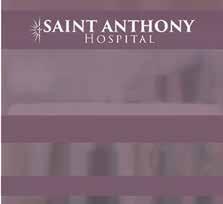
Illinois Coalition of Nursing Organizations Convenes Meeting on Violence in Healthcare

Violence towards nurses and other caregivers is escalating, it is becoming more common, and is actually spreading to all aspects of our families’ daily lives. The Illinois Coalition of Nursing Organizations (ICNO), an organization representing over 30 nursing organizations in Illinois, recently called a meeting to specifically address violence against nurses. We quickly realized that the focus has to broaden to include prevention as well as safety for all healthcare workers, volunteers, visitors, etc. Creating a culture of safety within healthcare becomes essential in fully addressing the problem of violence in the workplace.
ICNO is, “a voluntary unincorporated organization whose purpose is to work toward coordination and cooperation among participating nursing organizations in issues that relate to nursing practice, education, research and other matters of mutual concern” (American Nurses Association-Illinois, 2017, para. 2). A list of involved organizations is available on the group’s webpage http://www.ana-illinois.org/MainMenu-Categories/Health-PolicyPolitical-Action/ICNO
Nursing Organizations across Illinois gathered to focus our prevention and safety efforts and responses on the complex issue of violence in healthcare environments. Recognizing that many organizations and health systems are working to address this multifaceted issue, we felt the need for an organized, collective approach. ICNO strongly supports an approach that shares resources and tools, works collaboratively, and avoids duplicative endeavors. Recognizing that the problem is greater than violence against healthcare workers, we recognize that solutions are as complex as the problem; ICNO feels progress is always more effective when we work together.
According to the American Nurses Association (ANA; 2017), a culture of safety consists of “core values and behaviors resulting from a collective and sustained commitment by organizational leadership, managers and health care workers to emphasize safety over competing goals” (para. 1). Echoing this sentiment, the American Association of Nurse Anesthetists (AANA) published a position statement promoting a culture of
safety and encouraging healthy work environments. Healthy work environments provide the opportunity to optimize patient safety and improve the health and well-being of healthcare workers. As violence is a progression of disruptive behaviors, a healthy work environment encompasses a proactive broad approach to prevent violent actions. ICNO believes the responsibility of promoting a culture of safety lies with healthcare systems as a whole. The system empowers healthcare workers by providing education, resources, and opportunities to address issues and effect positive change. Quality healthcare requires an interdisciplinary, collaborative effort. As such, efforts to effectively address an issue as complex and challenging as violence against healthcare workers must represent a shared voice moving toward creating a culture of safety in all healthcare settings. Through ICNO, a collective conversation has begun. The next step is to reach out to other disciplines and stakeholders to broaden our voice.
Governor Rauner Signs House Bill 313
The signing of this bill completes a process that started back in April 2015 when the Illinois Coalition of Nursing Organizations met to work on revisions of the Nurse Practice Act.
We should be proud of the work we accomplished. Let us remember what our overarching goal was when we started: We wanted grant authority for all nurses (LPN, RN, and APRN) to practice to the fullest level of their education and expertise, while providing safe and quality nursing care in all settings. Recognizing
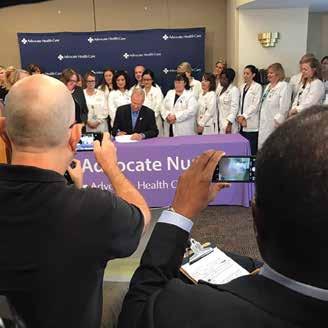
that healthcare is moving to the community instead of traditional facilities, ICNO focused on addressing the changing role of the nurse as a provider of direct care services, virtual services, and that of care coordination.
Our work continues as we work with IDFPR to fashion the rules. This will take time and we ask for your patience as we proceed. Rules are published for public comment so watch for more information as we will use our collective power to ensure there are no additional barriers added to the administrative rules.
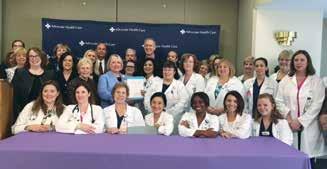
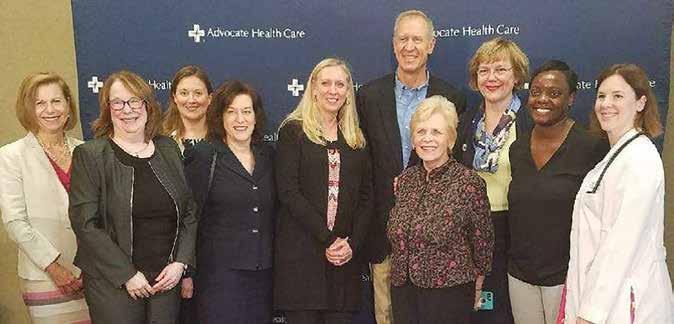
Elizabeth Stewart BSN, RN, CEN
PHN Workshop
On October 20, 2017, practice leaders in public health nursing gathered, along with community/public nursing faculty, to explore partnerships between public health agencies and nursing schools during a one-day conference entitled, Implementing Successful Public Health Nursing Academic-Practice Partnerships. The Illinois Public Health Nursing Academic Practice Partnership Workgroup (IL PHN APP) organized the conference as a forum to share wisdom and experiences gained through existing academic practice partnerships across Illinois.
Keynote speaker, Susan J. Zahner, DrPH, RN, FAAN Associate Dean for Academic Affairs and Vilas Distinguished Achievement Professor at the University of WisconsinMadison School of Nursing shared her wisdom in her address, “Partnering for Public Health Nursing Education and Practice.” She led the six year Linking Education and Practice for Excellence in Public Health Nursing (LEAP) project and Dr. Zahner stressed that the keys to successful partnerships are common purpose and mutual benefit.
Other activities included a panel discussion of partners involved with the five funded 2017 Pilot Projects with IL PHN APP, moderated by Pamela Levin, PhD, PHNA-BC, Rush University College of Nursing. These projects were supported by grants distributed by the IL PHN APP Workgroup. Attica Scott, MS, Community Coach at County Health Rankings & Roadmaps engaged the participants in a discussion around “Building a Culture of Health: Using Data to Advance Equity ." Susan Swider, PhD, PHNA-BC, FAAN, Rush University College of Nursing, reviewed the AACN Academic-Practice Partnership Toolkit, which served as a guiding framework for the pilot projects. Finally, participants joined in roundtable discussions around forming or advancing academic practice partnerships. Common successes and challenges associated with partnerships emerged throughout the day, including the formation of important linkages and competing timeframes.
Thanks to the generous support of the Robert Woods Johnson Foundation and the Illinois Nurses Foundation, over 80 participants were able to come together to learn from experts and each other about new ways for nursing students and public health agencies to partner to better educate future nurses in public health while providing new energy and much needed resources to agencies, public health nurses, and communities.
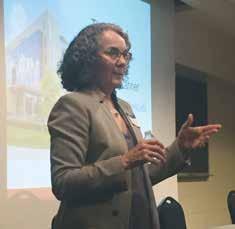
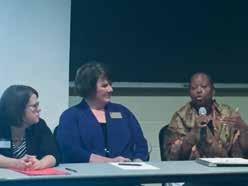
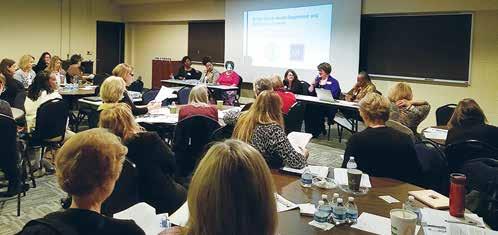
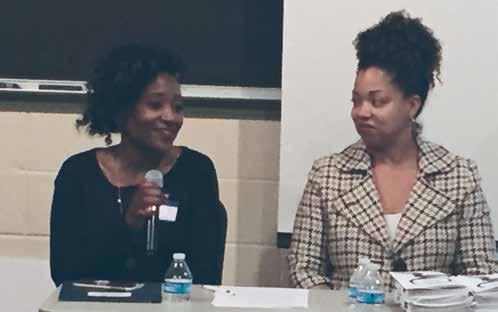




Susan J. Zahner, DrPH, RN, FAAN, Keynote Speaker
Monique Reed, PhD, RN, Sheila Sanders, Pilot Project Awardees
Laura Sztuba MSN, RN, PHNA-BC, Jan Albers DNP, RN, PHNA-BC, CLC, Glenda Morris Burnett PhD, MUPP, RN, Pilot Project Awardees
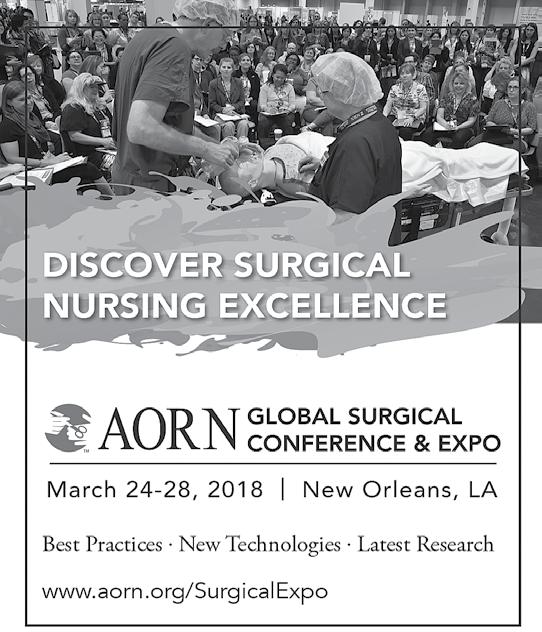

Lessons Learned from Successful Public Health Pilot Projects
The Illinois Public Health Nursing Academic-Practice Partnership launched in the Spring of 2016 to support pilot projects and hold a state-wide conference. Due to the State of Illinois budget impasse, however, recruitment via health departments and schools of nursing was hindered. Thankfully, external funding was secured from the Illinois Nurses Foundation/INF to support the pilot projects and the conference.
The pilot project application, submission, and reporting process was developed using a modified American Association of Colleges of Nursing AcademicPractice Partnership Toolkit. Five partnership pilot projects were awarded across Illinois during the Fall 2016 and Spring 2017 semesters.
Projects were funded at the following sites:
• McKendree University/St. Clair county Health Department: STI Prevention and Promoting Employee Wellness
• St. Xavier University/Cook County Department of Public Health: Immunization Adherence
• Olivet Nazarene University/Kankakee County Health Department: Immunization Compliance
• McKendree University/Jackson County Health Department: Asthma
• Rush University/EverThrive, Illinois/Chicago Public School: STI Prevention
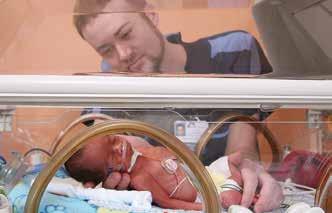
Lessons learned from the pilot projects include: the importance of coordinating meeting times in advance for partners to assess needs, identify problems, develop and evaluate intervention collaboratively; how increased engagement helps to establish trust and rapport; remaining flexible to foster a healthy working relationship; understanding how system and bureaucratic issues take additional time to address; and how to promote a diverse working group (i.e. race, ethnicity, thought).
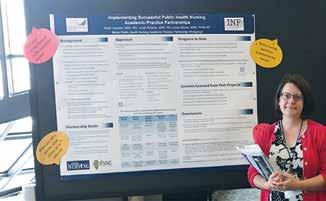


In September 2017, the Public Health Nursing Leaders Workgroup presented a research poster of these projects at the Illinois Public Health Association’s (IPHA) annual meeting and at the Centers for Disease Control (CDC) in Atlanta, Georgia. Laura Sztuba, MSN, PHNA-BC of the Kankakee County Health Department presented at IPHA’s annual meeting. Linda B. Roberts, MSN, RN, IDFPR/Illinois Center for Nursing and Robin Hannon MSN, RN, of the St. Clair County Health Department presented at the CDC. The Illinois Public Health Nursing Academic-Practice Partnership Workgroup members: Jan Albers, McKendree University; Karen Brown, Jackson County Health Department; Glenda Morris Burnett, St. Xavier University; Susan Day, Olivet Nazarene University; Robin Hannon, St. Clair County Health Department; Krista Jones, University of Illinois at Chicago; Pamela Levin, Rush University; Monique Reed, Rush University; Linda B. Roberts, Illinois Center for Nursing; Susan Swider, Rush University; Laura Sztuba, Kankakee County Health Department; Kim Whitmore, Loyola University.
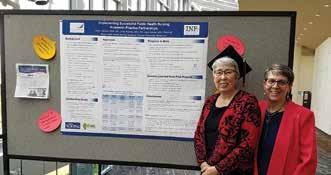

SNAI 2017 Annual Conference
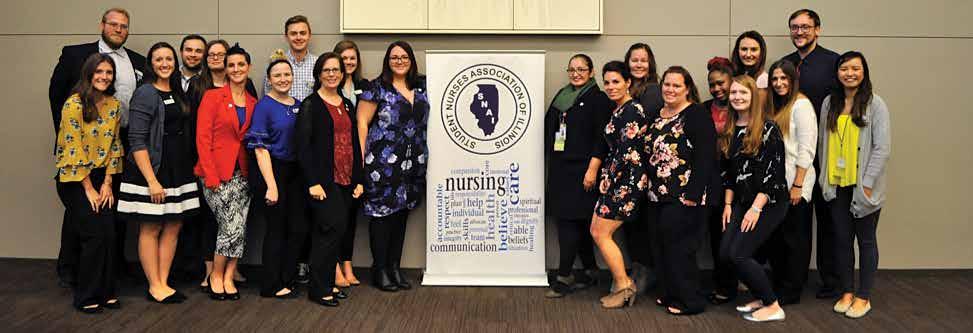
On October 7th, the Student Nurses Association of Illinois (SNAI) held their 68th Annual Convention at Loyola University in Chicago, Illinois. Registration reached 158 people, the largest attendance at a SNAI Convention in over 15 years. This was a powerful achievement for the outgoing board, especially in light of the Chicago Marathon, which was planned for the same weekend. Members opted to condense the event into a single day, removing the attendee obstacle of finding hotel accommodations, and ensuring success on their year-long goal of increased member engagement. Furthermore, this event drew in high school students who had the opportunity to talk with current nursing students and find mentors for their upcoming pursuits.
Not only was this convention outstanding in its attendance, but participants responded positively to the speakers. At the outset, both students and faculty alike sat enraptured by the keynote speaker, Bill Coon, as he painted a vivid picture of his experience in long-term treatment and the immense impact nurses, doctors and students alike had on him. Members were also atwitter after breakout sessions on Advanced Care Planning, Forensic Nursing, Mental Health Nursing and Nursing Informatics. The event wrapped up with the House of Delegates session, in which numerous new candidates vied for positions on the 2017-2018 Board of Directors, and a rousing round of raffle draws.
Laura Sztuba, MSN, PHNA-BC presenting at the Illinois Public Health Association annual meeting, Springfield, Illinois.
Robin Hannon, MSN, RN, St. Clair County Health Department and Linda B. Roberts, MSN, RN, IDFPR/Illinois Center for Nursing during poster session, Centers for Disease Control, Atlanta, Georgia.
Robin Hannon and Linda B. Roberts presenting a “commercial” to encourage the meeting attendees to stop by the poster during the designated time. Centers for Disease Control, Atlanta, Georgia.
Pictured above are the outgoing (left) and incoming (right) SNAI Board of Directors.
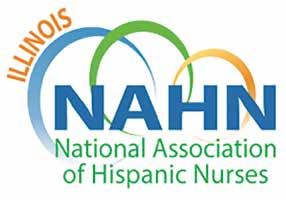
On May 18, 2017, the National Association of Hispanic Nurses-Illinois Chapter (NAHN-Illinois) celebrated the transition of their new Executive Board hosted at Norwegian American Hospital. Elizabeth Aquino, PhD, RN transitioned to the new Chapter President and Susana Gonzalez, MSN, MHA, CNML, RN became immediate Past President. Susana has been a supportive mentor to Dr. Florez and will continue to be an active board member. The new President-Elect is Lupe Hernandez, MSN, FNPBC; Secretary, Irene Mendez, BSN, RN; and Treasurer, Gloria Barrera, MSN, RN, PEL-CSN. The new executive board is passionate and motivated with new ideas to ensure that the chapter is visible and continues to grow. NAHN-Illinois, is a professional, voluntary and nonprofit healthcare organization, dedicated to enriching the lives of Hispanic nurse individuals through the promotion of academic attainment, professional advancement, cultural awareness, and active participation in the Hispanic Community. In addition, the association is committed to mentoring the next generation of Hispanic nurses to participate in the reshaping of our Healthcare system. In Dr. Aquino’s remarks she stated, “Our chapter will continue to focus on mentoring and supporting our members, community outreach, and building strong strategic partnerships. Also, to address the nursing shortage, we will also focus on increasing the pipeline of Hispanic nurses by working with grade schools and high schools to talk about nursing and the pathway to becoming a nurse.” NAHN-Illinois has many opportunities for members to network with nurses working in a variety of settings and specialties, be involved in community engagement activities, mentor others or be mentored, strengthen leadership skills, and much more. To learn more about NAHN-Illinois go to www.nahnillinois.org or email nahn.illinois@gmail.com

From left to right: Wanda Monterrubio, MSN, FNP-BC (Past Secretary), Nancy Garcia, BSN, RN (Past Treasurer), Susana Gonzalez, MHA, MSN, RN, CNML (Immediate Past President), Elizabeth Aquino, PhD, RN (Current President), Jose Sanchez (CEO/President of Norwegian American Hospital), Irene Mendez, BSN, RN (Secretary), Gloria Barrera, MSN, RN, PEL-CSN (Treasurer), Lupe Hernandez, MSN, FNP-BC (PresidentElect), Vicki Monterubio (Social Media and Public Relations Coordinator).

Left to Right: NAHN-Illinois Executive Board. Lupe Hernandez, MSN, FNP-BC (PresidentElect), Elizabeth Aquino, PhD, RN (President), Susana Gonzalez, MHA, MSN, RN, CNML (Immediate Past President), Gloria Barrera, MSN, RN, PEL-CSN (Treasurer), Irene Mendez, BSN, RN (Secretary)
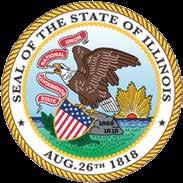
Renew, Print Your Nursing License with Ease Online RN/APN
renewal to open mid-March
The Illinois Department of Financial and Professional Regulation (IDFPR) is reminding licensed professionals that paperless licensing and renewals have been implemented for the 2018 Registered Nurse (RN) and Advance Practice Nurse (APN) renewal period. Submission of renewals for professionals may be completed online, 24/7 via IDFPR’s website (www.idfpr. com). Once a renewal is successfully processed, licensees will receive an email confirmation and be provided access to a copy of their license that may be printed at any time, free of charge via IDFPR’s Online Services Portal (https:// ilesonline.idfpr.illinois.gov/DFPR/Default.aspx).
ICN
Please note that all IDFPR correspondence are now delivered electronically, including renewal reminders (in lieu of the paper postcard). Licensees are strongly encouraged to visit IDFPR’s online address change webpage (https://www.idfpr.com/applications/ LicenseReprint/ ) to provide a current email address and ensure contact information is up-to-date and accurate. IDFPR encourages licensees to renew early to avoid any delays or lapses in licensing associated with late renewals.
For individuals with questions or concerns regarding licensure status or the renewal process, please contact IDFPR, toll free, at 1-800-560-6420 or by email: FPR. LMU@illinois.gov
Survey Request

Take 10 minutes after completing license renewal 2018 – Share Your Nursing and Workforce Statistics –Participate
Are there areas in the State where Registered Nurses (RNs) or Advanced Practice Nurses (APNs) are concentrated? Where are the greatest needs? Are there popular RN or APN specialties? How would the educational pipeline for RNs be best characterized? What are the APN physician-collaborator relationships? How might they change with the 2017 Nurse Practice Act?
We are asking for your help in answering these questions. In 2018 the Illinois Center for Nursing will again be offering the opportunity to participate in the collection of data. After completion of payment for Illinois RN or APN license renewal, nurses will see the following message:
“Although this report is not mandatory, your participation is critical, since employees in the field are our best and most reliable real-time source of
information available. By participating in this report, you will be helping to ensure that there will be an uninterrupted supply of nurses to meet the increasing future demands in the healthcare industry.”
The RN survey is 28 questions long, and takes about 10 minutes to complete. The APN survey is about 50 questions long and takes about 20 minutes to complete. Each survey captures data on the demographics, education, state distribution and practice foci in Illinois. All data will be reported in the aggregate for use in determining nursing workforce projections and needs in Illinois. Individual responses will remain anonymous and confidential. Participation in the survey is voluntary but very much needed and appreciated!
Past reports are available on the Illinois Center for Nursing website http://nursing.illinois.gov The 2016 RN report shows that the main employment setting for RNs was hospital/acute care settings (54%), this is similar to the 2014 RN survey results, but different from the 2000 survey, where approximately 64% RNs worked in hospital setting. The 2016 APN report will be available February 2018.
Illinois RN and APN license renewal will begin in March 2018 for the approximately 174,000 Illinois RNs and 13,000 APNs.
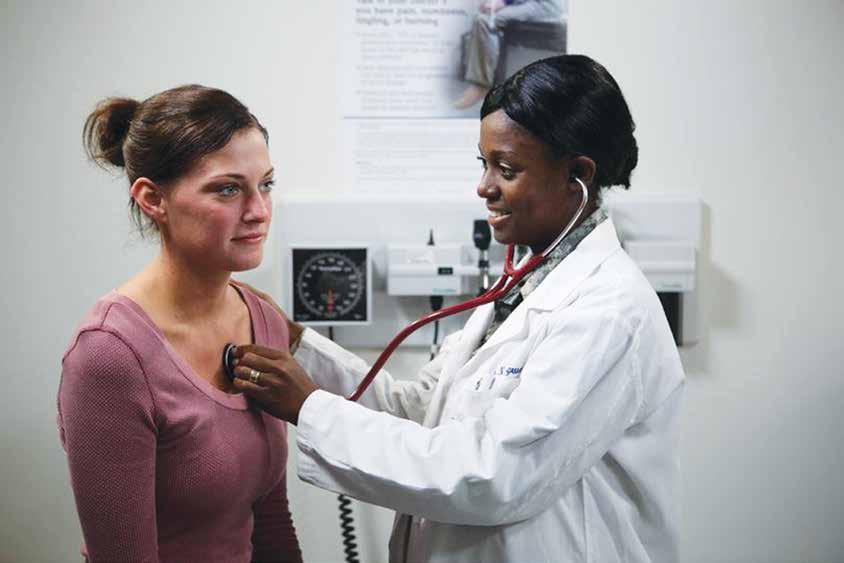

The Epidemic of Violence Against Nurses in the Hospital Setting
Dimitra Loukissa, PhD, MSN, PMHN-AC, RN Professor of Nursing North Park University, School of Nursing
Introduction
The purpose of this article is to explore the phenomenon of violence towards nurses and medical personnel in the clinical setting, identify causes, and present approaches that can assist in addressing this issue. Background information will be presented and vignettes will serve as the vehicle to apply basic concepts and identify possible solutions.
Outcomes
Upon review of this article and vignettes, the reader will be able to:
1. Understand the issue of violence in the health care setting.
2. Identify causes and recognize behaviors that have the potential to lead to violence.
3. Develop awareness of the effects of violence on clinical personnel.
4. Explore approaches and their application.
Background
Workplace violence is defined as “an act or a threat of physical violence, harassment, intimidation, or other threatening disruptive behavior that occurs at the work site” (United States Department of Labor). Similarly, the National Task Force on Violence against Social Care Staff defines violence as “incidents where persons are abused, threatened or assaulted in circumstances relating to their work, involving an explicit or implicit challenge to their safety, well-being or health” (Department of Health, 2000, pg. 7). Although workplace violence in general has been explored as a public health issue, violence towards healthcare providers is a rather neglected area, yet it presents a serious occupational hazard in hospitals at a national and global level (Campbell, McCoy, Hoffman, & Burg, 2014; Galinsky et al., 2010). From the health care provider groups, nurses are four times at greater risk to be attacked by patients or families (Yarovitsky et Tabak, 2009). In more recent years, national and international focus on patient violence has increased awareness, however, such incidents remain under reported (Campbell, Burg, & Gammonley, 2015; Hutchings et al., 2011). Most common presentations of aggression and patient violence may include verbal threats that greatly contribute to the development of emotional injury (yelling, sexual gestures, threatening to cause harm, cussing), but also physical assault (hitting, throwing an object targeting an individual, kicking, biting, slapping, pushing, spitting, squeezing, pulling hair, taking hostage). Literature reports have been consistent identifying the gap between reported events and unreported incidents of violence (Kvas & Seljak, 2014; Pompeii et al., 2013 & Spector, Zhou, et Che, 2014). Issues identified for this discrepancy involve lack of reporting when it comes to verbal threats, verbal abuse, or sexual threats. Interestingly enough, those events seem to be global. Talas, Koaoz et Akguc (2011) interviewed 270 hospital employees working in the Emergency Room area in Turkey and found that only about 50% of the staff reported experienced violence. Similarly, Di Martino (2002) studied the incidence of violence in health care at the international level and concluded that approximately one third of practitioners in Thailand did not disclosed experienced violence, whereas only one third of Bulgarian practitioners filed reports, followed by Portuguese and Australian practitioners who reported only 7% and 12% of all violent incidents respectively.
Results of a cross-sectional study conducted in Italy by Ferri, Silvestri, Artoni, et Di Lorenzo (2016) involving 745

health care providers found that nurses were the most frequently assaulted (67%), involving overwhelmingly psychiatric units, emergency departments, and geriatric wards. Yet, most employees documented violence primarily resulting in physical injuries. Sato, Yoshie et Fukahori (2016) examined 26 nurse managers’ experiences on handling patient and family aggression towards their nurses in Japan. Advocating for the patient, safeguarding staff safety, following institutional guidelines, and adhering to ethical-decision making processes were considered as key elements to prevent and address violence.

Nurses experience a variety of effects result of violence that can range from physical injuries, psychological effects such as distress, anger, anxiety, fear, and even long term consequences such as post-traumatic stress disorder or depression (Yarovitsky et Tabak, 2009).
Violence Indicators
In most cases there are cues that an individual is at higher likelihood to become aggressive. Those may range from body language such as tense or flushed face, rapid breathing, pacing, staring and mumbling to active behaviors such as refusing to follow redirection, invasion of personal space of the target individual or verbal violence. At times effects of medications or the patient’s condition itself involving cognitive deficit issues may contribute to the picture as well. Violence risk factors may include long wait in the emergency department, family member stress due to patient condition, few visible employees, lack of visible hospital security, small space, patient condition and symptomatology. It is imperative to understand that escalating behaviors that lead to physical violence are not only limited to attacking an individual but also include acts of aggression involving objects such as throwing furniture across the room or punching a hole on the wall.
Instrumentation
A number of scales and surveys have been developed over the years to capture data related to violence. For instance, the Overt Aggression Scale (OAS) is used to report incidents of patient violence, the Survey of violence experienced by staff (SOVES) focuses on patient and visitor violence and risk factors, but does not report incidents, whereas the Violence Incident Form (VIF) captures incidents that required medical attention (Altinbas et al., 2011; Hahn et al., 2013; Magnavita, 2014). Most of the instruments however are limited as they either measure one aspect of the event or lack generalizability.
Vignette 1
Mr. B. an 84 year old nursing home resident for the past 4 years, was admitted in a medical floor of the hospital to receive treatment for a urinary tract infection. Mr. B. has limited mobility, has been experiencing anxiety and confusion related to the infection and he is asking “to go home ." As the nurse was helping him to put his shoes on, Mr. B. kicked her in the face so hard that the nurse lost her balance and fell on the floor. She suffered a broken nose.
Vignette 2
Mary, a 16 year old adolescent patient with the diagnosis of bipolar disorder was admitted in a locked psychiatric unit for mood regulation and medication adjustment after she punched a nurse at her group home and attempted to elope.
Vignette 3
Mr. T. a 54 year old polysubstance abuser who was transferred from surgery to a medical floor two days ago, after he was operated on to have a bullet extracted from his abdomen attacked the nurse with the IV pole when he was told that he was not due yet for additional pain medication.
Vignette 4
An 85 year old confused bedridden female patient spit on the face of the nursing assistant who was providing care and grabbed her by the hair pulling hard and not letting go.
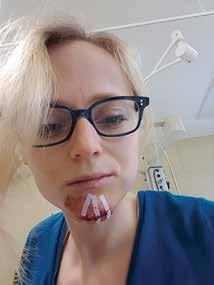
Vignette 5
A 35 year old homeless individual suffering from schizophrenia who was admitted involuntarily for threatening people in the community, pushed his way through the nursing station chasing after the psychiatrist who announced to him that he had to comply with medication before considering discharge. As staff members attempted to stop him he became physically aggressive and started punching and kicking them. Two of the staff members were sent to employee health for injuries they sustained.
Vignette 6
Ms. T., the daughter of a 72 year old female patient who was admitted for delirium work up physically attacked the nursing assistant and started punching, kicking and pulling her hair when she was told that her mother had suffered a fall that morning that resulted in a hip fracture and needed surgery.
Interventions
Having an understanding of the concept of violence, becoming aware, assessing situations and intervening before a behavior escalates further is considered to be the gold standard when it comes to aggression prevention. Although hospital guidelines may vary, the prevention principles seem to be universal. Similarly to the nursing care plan process it is imperative that each patient receives the appropriate screening and an updated plan of care that includes risks but also suggested interventions. Koller (2016) emphasizes the importance of violence prevention training in the emergency department setting. Training that focuses on identifying potentially violent patients, modification of nurses’ behaviors to decrease patient triggers, and specific strategies to address violence are considered important elements of safety. The issue of personal space is also important to keep in mind along with elimination of items that can contribute to further damage should a physical attempt takes place (jewelry and lanyards, accessible stethoscopes, caregiver’s hair within reach).
Removing self from a volatile situation is also considered a successful intervention as is allows the patient to destimulate, but also the caregiver to get to a safer place. The use of clinical safety strategies when caring for a patient include assessment of patient presentation, level of irritability, contributing factors such as medication side effects, confusion, experienced pain, but also adoption of appropriate interventions including administration of medication for anxiety, frequent brief contacts as tolerated, or staff having direct access to an exit.
State and Federal Initiatives
Although some states have passed their own rules to mandate hospitals to protect nurses from patient violence, there are no guidelines on this important issue at the federal level. Despite the lack of standardization on how to address the issue, hospitals are mandated to train employees on violence prevention. Currently California mandates health care employers to develop violence management interventions taking into consideration employee input (Fernandez Campbell, 2016). Other states have increased criminal penalties for assaults against nurses. Similarly, the Pennsylvania House of Representatives House Bill 2108 considers acts of violence against medical professionals as “aggravated assault” (Mercer Ray et Ream, 2007). It is expected that due to the severity and the urgency of the issue the U.S Department of Labor will be implementing nationwide safety guidelines for hospital personnel in the near future.
Discussion and Nursing Applications
Literature reviewed acknowledges that patient violence towards nurses and health care providers is an escalating but underreported national and global phenomenon. There is a general consensus that it is imperative to ensure accurate reporting of violent events from patients and visitors against health care workers to bring about awareness and address the issue successfully. Comprehensive information on prevalence of violence, causes of aggressive behaviors as well as appropriate interventions play a key role in addressing this issue. The majority of instruments tend to focus more on the broader term of work place violence and much less on patient violence towards health care personnel, and they lack reliability and validity (Campbee, Burg, et Gammonley, 2015). Although psychiatry, geriatrics, and ER medicine are considered to be the most frequently affected settings, other specialties are not excluded. Health care providers in general and nurses in particular often times see those scenarios as “part of the job” thus, rationalizing aggressive behaviors, however education on workplace violence and hospital support of “zero tolerance” policies can assist in addressing the issue. Nurses are in a unique position to consistently report related incidents but also recognize signs of escalation and implement effective intervention approaches. Further research can assist in identifying and preventing staff burnout as well as a plethora of physical health and psychological consequences. Moreover, health care organizations need to develop policies and support personnel through education and resources, but also by communicate to the public that such behaviors are not tolerated. Finally, attention of this issue needs to be brought up at the federal level through advocacy of professional organizations to ensure that hospital settings remain violence free.
Press Releases/Professional Publication Headlines
“This great-grandmother Wants to end ‘The Dirty little Secret of Nursing’ ” The Boston Globe (7/7/2017)
“A Patient’s Daughter Throws Scalding Tea in Nurse’s Face” Nursetogether.com (7/14/2016)
“Lost Another One: Nurse was Stabbed to Death” nursetogether.com (6/2/2016)
How Can We Make the Violence Against Healthcare Workers Stop?” BestNursingDegree.com (3/2016)
Nurse Stabbed With A Syringe: Is She The Villain?” Nursetogether.com (6/6/2016)
“Massachusetts Nurses Push for Workplace Violence Bill” Modern Healthcare (7/21/15)
“Where Hell is Other Patients” The New York Times (11/10/2014)
“One Nurse’s Story: Violence in the E.D. Ended My Career” Nursetogether.com (9/17/2014)
CE Offering
1.0 Contact Hours
This offering expires in 2 years: December 1, 2019
Learner Outcome:
After reading the article, the nurse will be able to discuss the phenomenon of violence towards nurses and medical personnel in the clinical setting, identify causes, and present approaches that can assist in addressing the issue.
HOW TO EARN CONTINUING EDUCATION CREDIT
This course is 1.0 Contact Hours
1. Read the Continuing Education Article
2. Go to https://ilnursesfoundation.wufoo.com/ forms/dec-2017self-study/ to complete the test and evaluation. This link is also available on the INF website www.illinoisnurses.foundation under programs.
3. Submit payment online.
4. After the test is graded, the CE certificate will be emailed to you.
HARD COPY TEST MAY BE DOWNLOADED via the INF website www.illinoisnurses.foundation under programs
DEADLINE TEST AND EVALUATION MUST BE COMPLETED BY DECEMBER 1, 2019
Complete online payment of processing fee as follows:
ANA-Illinois members- $7.50 Non members- $15.00
ACHIEVEMENT
To earn 1.0 contact hours of continuing education, you must achieve a score of 80% If you do not pass the test, you may take it again at no additional charge Certificates indicating successful completion of this offering will be emailed to you.
The planners and faculty have declared no conflict of interest.
ACCREDITATION
This continuing nursing education activity was approved by the Ohio Nurses Association, an accredited approver by the American Nurses Credentialing Center’s Commission on Accreditation. (OBN-001-91)
CE quiz, evaluation, and payment are available online at https://ilnursesfoundation.wufoo.com/ forms/dec-2017self-study/ or via the INF website www.illinoisnurses.foundation under programs.

SimpleWreath

Etsy: http://www.etsy.com/shop/simplewreath Facebook: https://www.facebook.com/simplewreath E-mail: simplewreath@gmail.com




Thank you to our Sponsor & Exhibitors
Thank you to our Sponsor & Exhibitors
Arthur L. Publishing Agency, Inc - SPONSOR
Arthur L. Publishing Agency, Inc - SPONSOR
Illinois Nurses Foundation
Illinois Nurses Foundation
Aurora University
Feel Good, Inc.
Aurora University
Illinois Association Of School Nurses
Feel Good, Inc.
Illinois Public Health Association
Indiana Weslyan University

Illinois Association Of School Nurses
McKendree University
Illinois Public Health Association
Memorial Health System
Olivet Nazarene University
Indiana Weslyan University
University of St. Francis
McKendree University
Western Governors University Nurses PAC
Memorial Health System
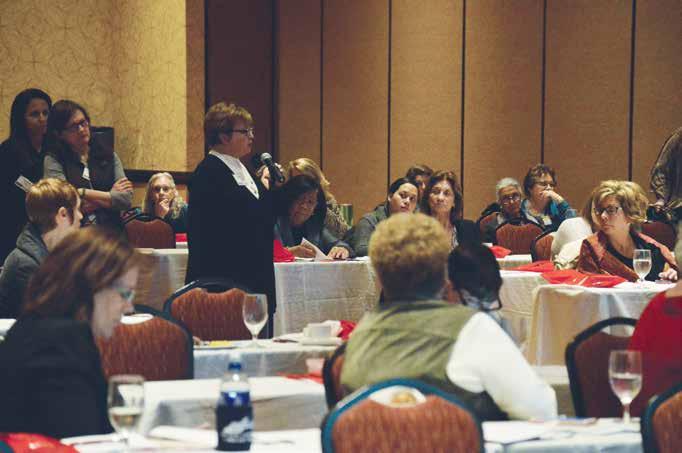
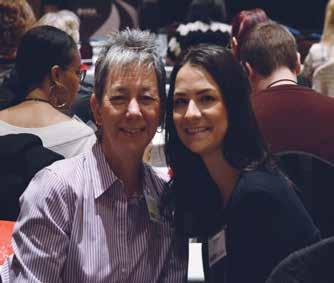
Olivet Nazarene University
University of St. Francis
Western Governors University Nurses PAC
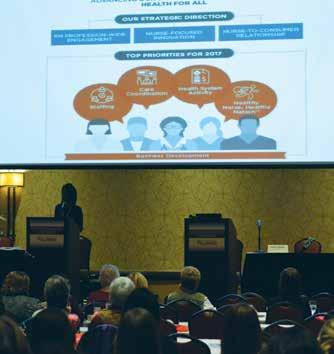

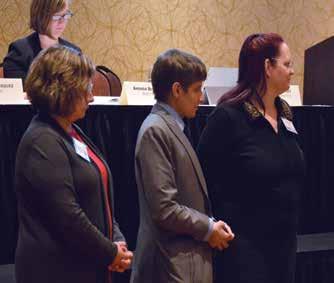
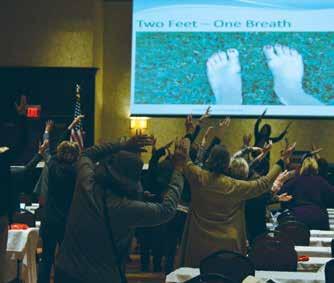

Remember the Past, Embrace the Present, Unite for a Greater Future
Gloria Simon, Med, BSN, FN, RN. PNAI
President 2016-2018
Bryan Ranchero, BSN, PHN, CCNC. RN. PNAI President Elect
The Philippine Nurses Association of Illinois, Inc. (PNAI) celebrated their 60th Diamond Jubilee Anniversary (1957-2017) on Saturday October 14, 2017. Though the rain storm and floods delayed the start, it could not dampen the spirits of the nursing leaders, friends and family.
President Gloria Simon encouraged us to rally Filipino nurses in Illinois, through teamwork, to lead our professional association and to be in the forefront of nursing in a rapidly changing health care system, locally, nationally, and globally. To help us visualize PANI’s theme for the focus of this year’s work she asked us to visualize the ancient Roman mythology god Janus – the god of beginnings and transitions. He is usually depicted with two faces looking in opposite directions. President Simon emphasized that she chose this symbol so that as we move forward embracing the future, we don’t forget.
The celebration included remarks from Melchor P. Lalunio, Jr., Counsul General of the Republic of the Philippines, Chicago. He asked the attendees to stand, turn to their left, then right and greet the person next to them. He encouraged everyone to work in coalition to move us forward, and that working together starts with a simple hello.
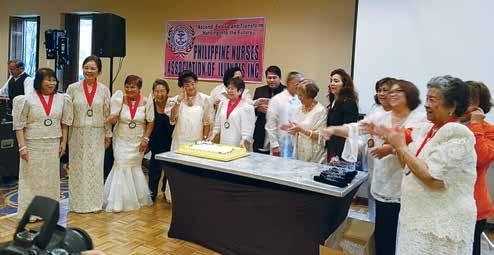
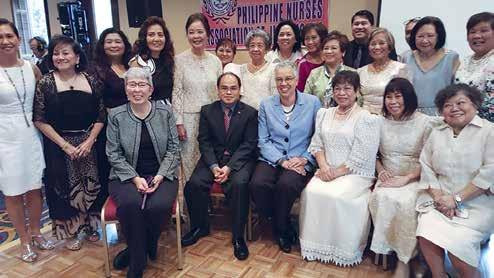
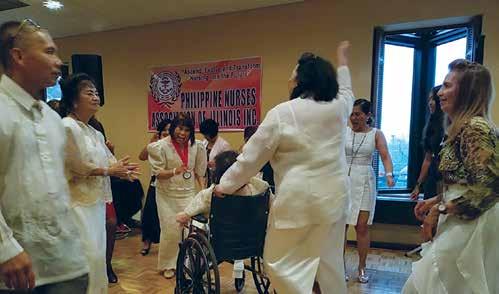
Philippine Nurses Association of America (PNAA) President-Elect Madeline Yu, New Jersey, thanked PNAI for their leadership, as the oldest incorporated chapter in the US, in the many past PNAI presidents who became PNAA president, in their collaboration with other nursing organizations, and their work in the community. Linda B. Roberts, Illinois Center for Nursing Manager also spoke about inter-professional collaboration as we continue work on the Robert Wood Johnson Foundation Future of Nursing (2010) recommendations.
Past PNAI Presidents were honored with medals commemorating the 60th Diamond Jubilee Anniversary. There were dancers, singers, a skit, and of course the day ended with more celebrating and dancing.
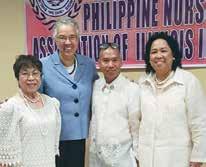
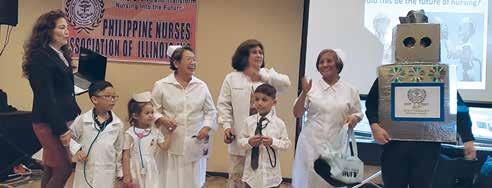
























(L-R) Philippine Nurses Association of Illinois President Ret. Capt. Gloria Simon, Med, BSN, FN, RN; Cook County Board President Toni Preckwinkle; PresidentElect Bryan Ranchero, BSN, PHN, CCNC, RN; Alma Jaromahum, PhD, MSN/MAN, APRN, CCRN, RNC, Immediate Past-President.
Recognition of past presidents – each received a 60th anniversary medal on a red ribbon. (L-R): Clarita Go Miraflor, Rn, PhD; Lourdes M. Nisperos, RN, MSN; Imelda Cuevo, BSN, RN; Ret. Capt Gloria O. Simon, Med, BSN, RN; Dionisia F. Battung, RN, BSN, Med.
Skit: past, present and future nurses.
Nurse leaders with (center) Melchor P. Lalunio, Jr, Philippine Consul and Cook County Board President Toni Preckwinkle.
PNAII 60th Diamond Jubilee Celebration – dancing.

Congratulations to Gloria Barrera
Recipient of the Dr. Garry Gardner healthcare provider award from Everthrive Illinois
Gloria E. Barrera, MSN, RN, PEL-CSN School Nurse and Adjunct Professor of NursingDePaul University, Chamberlain College of Nursing, and Capella University
For her commitment to her students and their families in School District #229. Your tireless efforts to advocate on behalf of your clients, your ability to connect people to the resources they need when they need them exemplify the spirit of our beloved Dr. Garry Gardner.

Successful NCLEX® Regional Workshop
On September 15, 2017 Harper College in Palatine, Illinois hosted a NCLEX® Regional Workshop for Illinois nursing educators. One hundred nursing educators attended the one day workshop to assist them with understanding the updated NCLEX test plan. This workshop was a board of nursing-sponsored regional workshop conducted by NCSBN Examinations department content staff that provided information to educators who prepare students to take the NCLEX examination. Faculty had the opportunity to network and develop alternate item format questions, which reinforced how the NCLEX exam is changing. At the end of the program resources were provided for faculty regarding how to understand their schools’ NCLEX results through Mountain Measurement, Inc. and on-line courses providing continuing education credit through National Council State Boards of Nursing (NCSBN) to further instructor knowledge on the Assessment of Critical Thinking, Test Development and Item Writing and Understanding NCLEX. For further information go to www.learningext.com and https:// reports.mountainmeasurement.com
Please send to appropriate person.
Julie D’Agostino, MS, RN, Director of Nursing
William Rainey Harper College │ Nursing Programs Building X Room 250 Division Office 1200 West Algonquin Road │ Palatine, Illinois 60067

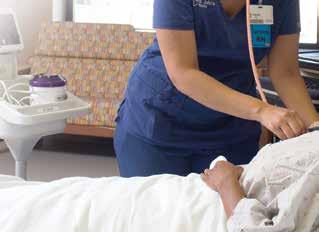
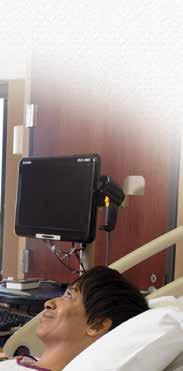





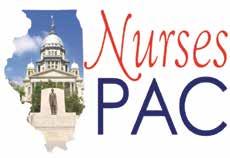
Nurses want to provide quality care for their patients.
The Nurses Political Action Committee (Nurses- PAC) makes sure Springfield gives them the resources to do that.
Help the Nurses-PAC, help YOU!
So. . . . . . . if you think nurses need more visibility if you think nurses united can speak more effectively in the political arena if you think involvement in the political process is every citizen’s responsibility.
Become a Nurses-PAC contributor TODAY!
❑ I wish to make my contribution via personal check (Make check payable to Nurses-PAC).
❑ I wish to make a monthly contribution to NursesPAC via my checking account. By signing this form, I authorize the charge of the specified amount payable to Nurses-PAC be withdrawn from my account on or after the 15th of each month.
(PLEASE INCLUDE A VOIDED CHECK WITH FORM)
❑ I wish to make my monthly Nurses-PAC contribution via credit card. By signing this form, I authorize the charge of the specified contribution to Nurses-PAC on or after the 15th of each month.
❑ I wish to make my annual lump sum Nurses-PAC contribution via a credit or debit card. By signing this form, I authorize ANA-Illinois to charge the specified contribution to Nurses-PAC via a ONE TIME credit/debit card charge.
❑ Mastercard ❑ VISA
ANA-Illinois Expert Panel: Workplace Safety Survey 1
News stories about nurses experiencing escalating violence in the workplace are becoming more common place, and Illinois nurses represent some of these stories. As violence in the workplace becomes more common, more and more nurses express concern about their personal safety at work. In response to this growing concern, ANA-Illinois convened an expert panel to study workplace safety. The expert panel members developed a series of surveys to assess how nurses’ perceive safety in their workplace. The surveys were distributed by ANA-Illinois through E-Mails and a publication called “The Voice” (an Illinois Nurses Foundation publication distributed to professional nurses in IL). The first survey posed the following question: “Please rate your perception of the level of safety in your workplace,” rated on a scale of 1 – 5, with 1 being the least safe. Nurses were asked to provide examples of safety concerns in their workplace. Almost 60% (57.7%) of nurses rated their workplace as “more safe” (4-5). Close to 40% (37.9) rated their workplaces as “less safe,” and about 4% (3.66) rated their workplace as least safe. It is very troubling when more that 40% of nurses describe their workplace as less than safe. The common concerns among Illinois nurses include 1) Open access to the workplace, 2) Staffing levels, and 3) Behavioral Problems.
Almost 30% (28%) of respondents shared examples of safety issues related to open access.
“Allow unidentified people in… people walk into clinics asking people in the waiting rooms for money…located in high crime area with easy access… easy access to hospital at all times…police bring in patients involved in crimes or just released from criminal justice system…office is unlocked with total access at at all times…many gangs in the area with easy access…unsupervised people allowed to enter… no secured access to staff only areas …anyone can walk in at any time…alone in office late with easy access…easy access to parking lots, and I work late… open access to buildings…no ED entrance security.”
Almost 30% (26%) of respondents shared examples of safety issues related to staffing levels.
“no breaks…multitasking, rarely able to focus on one task/patient at a time…understaffed…admission of multiple patients at a time with no control over timing… inadequate resources [nurses and security staff] to care for patients…lack of adequate security personnel to handle threatening patients or families…increased workloads with inadequate staff…more novice staff than experienced staff increases workload…lack of safe staffing levels…too many residents to care for…low staff with high acuity patients…work overload common...lack of adequate [nursing]staff…lack of security personnel… no text or other alarm system [to warn of shooter or other threat”
Twenty-two percent (22%) of respondents shared examples of safety issues related to erratic behavior or behavioral problems.
“combative patients like traumatic brain injuries… high volume of criminal patients…working with patients with substance abuse…altercations with co-worker…threats against me by co-worker… nurse bullying and discriminatory behavior… violent mentally ill patients…incivilityamong staff and management…patients with mood lability… patients with weapons more common…waiting rooms wherepeople have weapons and threaten others…working in emergencyareas where nurses are threatened and assaulted…worry about angry patients, we have no security, no panic button, or alarmsystem…students increasingly agitated and aggressive.. more and more aggressive3 patients, increased number of {patients}with unstable behavioral problems…going into patient home wherethere are weapons…parents get angry and threaten staff…dealing with psychotic and aggressive patients…taking care ofmultiple dangerous patients at one time, and unable to refuse admissions…lack of security to handle criminal patients”
Violence in the workplace effects all caregivers, other workers, visitors, volunteers, etc. ANA-Illinois believes that workplaces could focus on the above common concerns to develop or revise safety plans, plus policies and procedures to better protect caregivers and their patients, as well as others in the workplace. Surveys with a narrower focus have been distributed, and results will be shared in future editions of the Voice.






